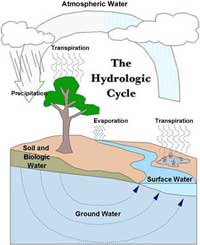
 |
|
figure
1. Click on image for larger view.
|
Groundwater is the water that lies below the surface of the ground and fills the pore space as well as cracks and other openings. Porosity is the percentage of a rock's volume that is taken up by openings. Most sedimentary rocks such as sandstone, shale and limestone can hold a large percentage of water. Loose sand may have a porosity of up to 40 percent; however, this may be reduced by half as a result of recrystallization and cementation. Even though a rock has high porosity, water may not be able to pass through it. Permeability is the capacity of a rock to transmit a fluid such as water. For a rock to be permeable, the openings must be interconnected. Rocks such as sandstone and conglomerate have a high porosity because they have the capacity to hold much water.
To understand porosity versus permeability, visualise that a sponge is both porus and permeable- meaning that it can both hold and transmit water. Styrofoam is an example of a material that is very porous, but lacks porosity. Thus styrofoam, though spongy, does not absorb or transmit water.
Why
is Groundwater so Important?
Ground water is the second
largest reservoir of water in the hydrologic cycle (Figure
2). But more importantly, it is the predominant source of drinking water
in many western states. For example, ground water provides more than 95% of
the drinking water used in Idaho.
*Figure 3 shows the relative amounts of ground water and surface water used in Idaho (based on 1995 data).The amount of ground water used in southeast Idaho, alone, was more than 800 million gallons per day. Of this, over 90% was used for agricultural purposes. *Figure 4a and *4b summarizes ground water use in southeast Idaho by county. For example, in Bannock County, ground water provided all of the drinking water used, or about 23 million gallons per day.